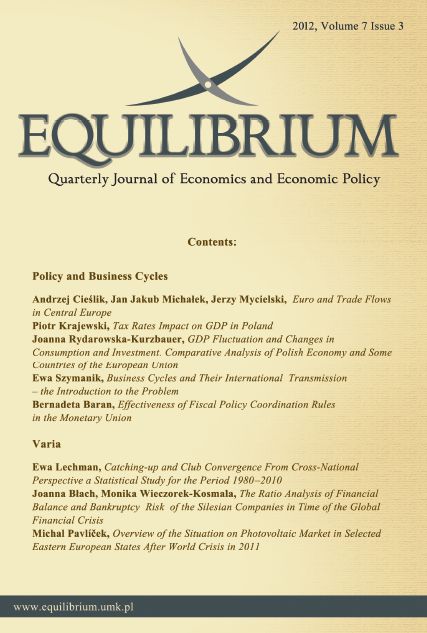Business Cycles and Their International Transmission – the Introduction to the Problem
DOI:
https://doi.org/10.12775/EQUIL.2012.019Keywords
business cycle, crisis, transmission of cyclesAbstract
The article presents the problem of business cycle transmission and the role of canals of transmission in the contemporary world. Because of the theoretical character of the problem the used methodology is a presentation of the results of the researches and theoretical works about the problem of crisis sources and their transmission.References
Ahmed S., Ickes B., Wang P., Yoo B.S. (1993), International Business Cycles, “The American Review”, June.
Alessandria G., Choi H. (2004), Export Decisions and International Business Cycles, Society for Economic Dynamics, NY University, Meeting Papers 54, New York.
Arkolakis C., Ramanarayanan A. (2009), Vertical Specialization and International Business Cycle Synchronization, Federal Reserve Bank of Dallas, Globalization and Monetary Policy Institute, “Working Paper” No. 21, September .
Artis M. (2003), Is there a European Business Cycle?, CESifo “Working Paper” No.1053, Category 5: Fiscal Policy, Macroeconomics and Growth, October.
Artis M., Okubo T. (2008), Globalization and Business Cycle Transmission, CEPR “Discussion Paper” 7041, Kobe, October.
Azevedo J. (2002), Business Cycles: Cyclical Comovement Within the European Union in the Period 1960-1999. A frequency domain approach, “Working Paper” WP 5-02, Banco de Portugal.
Backus D. K., Kehoe P.J., Kydland F. E. (1993), International Business Cycles: Theory vs .Evidence, The Federal Reserve Bank of Minneapolis, Quarterly Review 1742, Fall 1.
Baldwin R. E, Krugman P. (1989), Persistent Trade Effect of Large Exchange Rate Changes, “Quarterly Journal of Economics”, 104(4).
Barczyk R., Kąsek L., Lubiński M, Marczewski K. (2006), Nowe oblicza cyklu koniunkturalnego, PWE, Warsaw.
Bergman M. (2004), How Similar Are European Business Cycles?, “Working Paper” No. 2004:9, Lund University, Department of Economics.
Bergman U.M., Bordo M.D., Jonung L. (1998), Historical Evidence on Business Cycles: The International Experience, [w]: Beyond Shocks: What Causes Business Cycles, Federal Reserve Bank of Boston, Conference Series 42, ed. J.C. Fuhrer and S. Schuh, June.
Bocutoglu E., Ekinci A., Austrian Business Cycle Theory and Global Crisis, “Mises Daily” 5.02.2010, dostępne na http://mises.org/daily/4072 (stan na dzień 14.12.2010).
Bordo M. D., Helbling T.F. (2010), International Business Cycle Synchronization in Historical Perspective, NBER Working Paper Series, “Working Paper” 16103, NBER, Cambridge, June.
Caplin A., Leahy J. (1994), Business as Usual, Market Crashes and Wisdom after the Facts, “American Economic Review”, No.3.
Crucini M.J., Kose M.A., Otrok Ch. (2008), What Are the Driving Forces of International Business Cycles?, NBER “Working Paper” No. W 14380, October
red. Dach Z., Szopa B. (2004), Podstawy makroekonomii, PTE, Cracow.
Flejterski S. (2010), Globalny kryzys bankowo – finansowy. Geneza, aktorzy, konsekwencje, w: Kołodko G. (red), Globalizacja, kryzys i co dalej?, Poltext, Warsaw.
Frankel J.A., Rose A.K. (1998), The endogeneity of the optimum currency area criteria, “The Economic Journal” 108 (449).
Gerlach S., Smets F. (1995), Contagions Speculative Attacks, “European Journal of Political Economy”, No. 1.
http://wwwl.worldbank.org/economicpolicy/managing%20volatility/contagion/definitions.html, (accessed on 15,12.2010).
Hübner D., Lubiński M., Małecki W., Matkowski Z. (1994), Koniunktura gospodarcza, PWE, Warsaw.
Jakimowicz A. (2003), Od Keynesa do teorii chaosu, PWN, Warsaw.
Jankowiak J. (2010), Dług publiczny: garb albo lewar?, “Pioneer”, grudzień, nr 2
Kalecki M. (1979), Próba teorii koniunktury, [w]: Kalecki M., Dzieła, t.1. Kapitalizm. Koniunktura i zatrudnienie, PWE, Warsaw.
Kaminsky G. L., Reinhart C. M., Vegh C. A. (2003), The Unholy Trinity of Financial Contagion, NBER “Working Paper” No. 10061, Cambridge, November
Kollmann R., Enders Z., Müller G. J. (2010), Global Banking and International Business Cycles, ECORE Discussion Paper, 2010/79.
Kose M.A., Otrok Ch. (2008), Global Business Cycles: Convergence or Decoupling?, IZA Discission Paper Series, “Discussion Paper” No. 3442, April.
Mazurek Sz. (2009), Ścieżki międzynarodowej transmisji kryzysów, [w]: Czech-Rogosz J., Pietrucha J., Żelazny R. (red), Koniunktura gospodarcza od bańki internetowej do kryzysu subprime, wydawnictwo BECK, Warsaw.
von Mises L.H.E., The Austrian Theory of the Trade Cycle, http://www.mises.org, (stan na dzień 15.12.2010).
Obstfeld M. (1994), The Logic of Currency Crises, NBER “Working Paper” No. 4640, Cambridge, September.
Rabanal P., Rubio-Ramírez J. F., Tuesta V. (2009), Cointegrated TFP Processes and International Business Cycles, IMF “Working Paper” WP/09/212, September.
Rosati D.(2010), Przyczyny i mechanizm kryzysu finansowego w USA w latach 2007-2009, [w]: Kołodko G. (red), Globalizacja, kryzys i co dalej?, Poltext, Warsaw.
Skrzypczyński P. (2006), Analiza synchronizacji cykli koniunkturalnych w strefie euro, NBP, „Materiały i Studia”, zeszyt nr 210, Warsaw, September.
Stock J.H., Watson M.W. (2003), Understanding Changes in International Business Cycle Dynamics, NBER “Working Paper” 9859, NBER, Cambridge, July.
Szymanik E., Zyguła A.(2009), Cykliczne wahania aktywności gospodarczej, Krakowskie Towarzystwo Edukacyjne sp. z o.o., Oficyna Wydawnicza AFM, Cracow.
Yılmaz K. (2009), International business cycle spillovers, Tüsіad-Koç University Economic Research Forum, “Working Paper” 0903, September.
Zarnowitz V. (1985), Recent Work on Business Cycles in Historical Perspective: A Review of Theories and Evidence, “The Journal of Economic Literature”, volume 23.
Downloads
Published
How to Cite
Issue
Section
Stats
Number of views and downloads: 182
Number of citations: 0



